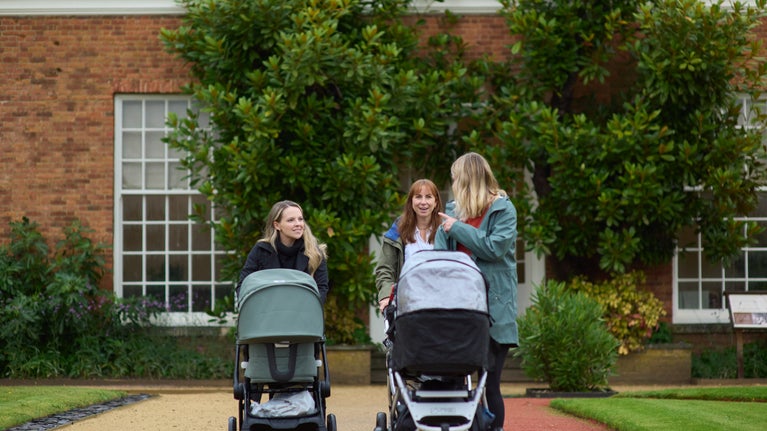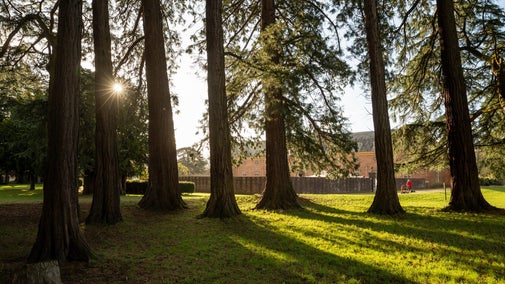
Discover more at Tredegar House
Find out when Tredegar House is open, how to get here, the things to see and do and more.

Discover three gardens at Tredegar House: the colourful and wild Orchard Garden, the Cedar Garden with its large herbaceous borders and the Orangery Garden with its ornate parterre. Visit the monument erected to a much-loved horse of the first Lord Tredegar, 'Sir Briggs', who lived to enjoy a happy retirement at Tredegar.
The largest of the three gardens, complete with an orchard full of apple trees and hidden pathways, there’s plenty of surprises to uncover.
The first detailed layouts of the garden in 1827 reveal a very productive garden, a level of self-sufficiency needed for a large mansion. As you wander through the garden, look out for the old pipes from long-gone hothouses where the Morgan family grew tropical fruit.
The exotic and ornamental features were added during the 19th and 20th centuries, giving a quirky feel to the Orchard Garden. In the 1930s the area towards the Gardener’s Cottage was used to house parts of Evan Morgan's menagerie.
Perhaps the best feature of the Orchard Garden is the partnership that helps to care for it. For more than 20 years Growing Space, a registered mental health charity based in Newport, has looked after the garden. They provide work skills and support for adults with mental health conditions, to improve their quality of life and help them reach their life goals.

It’s likely that the Cedar Garden with its early origins and closeness to the house was once the Morgan family’s ‘Best Garden’. Flanked by imposing gateways and framed by large herbaceous borders, the Cedar Garden still retains its 19th-century layout divided by a central axial pathway.
Dominated by a 250-year-old Cedar of Lebanon tree, the last of a possible six Cedar plantings, the Cedar Garden is a favourite spot for lounging, picnicking and playing. Keep an eye out for bear’s breeches, irises and forget-me-nots in the garden’s herbaceous borders.
At the heart of the garden is a stone obelisk, erected in memory of ‘Sir Briggs’, the horse who carried Godfrey Morgan, the first Lord Tredegar, during the Charge of the Light Brigade. Following the battle, Sir Briggs retired to Tredegar House to live out the rest of his days until he died in 1874 at the ripe old age of 28.
The garden is not only the resting place of this heroic horse, but also features three more headstones dedicated to the family's much-loved dogs Peeps, Friday and Barry.

The Orangery Garden is the smallest of the three gardens and gives an impression of how it would have looked more than 200 years ago when the Morgans lived here.
The intricate, undulating design of the ornamental parterre display features a variety of different-coloured minerals including seashells, crushed lime mortar, brick dust, coal dust, white and orange sands and grass.
During the 1930s the Orangery was not only used by Evan Morgan for his infamous garden parties, but also as a place to keep his exotic birds. The Orangery now houses a variety of fruit trees and herbaceous plants known to have been grown during the 18th century.
The most impressive feature of the Orangery is the 42-foot-long Cefn Mabli Shovelboard. One of the great wonders of Wales, this shovelboard is the longest single plank oak table-top in Britain. Made in the Civil War period for Cefn Mabli House, the shovelboard was already famous in the 17th century.
- Thomas Dinely, 1684
After visiting the formal gardens, why not visit the Laundry Garden in the Home Farm? Renovated as an accessible community garden in 2019, this green space is filled with bee-friendly plants, vegetables and even has a quiet space for those looking to avoid the crowds and have a moment of peace in nature. The Laundry Garden is free to access between 10.30am and 4pm.
Treasure all that Mother Nature has to offer this season, with our ’50 Things To Do Before You’re 11 ¾’ activities. Make the most of the wet weather by going welly wandering, or hunt the hedgerows to find some funky fungi. Activity sheets can be collected from visitor reception or downloaded here.

Find out when Tredegar House is open, how to get here, the things to see and do and more.
Delve into the history of this special mansion and the proud Welsh Morgan family who owned it for more than 500 years. Read about their flamboyant past including tales of eccentricity and a working-class rebellion.

Discover the top things to see and do when you visit the parkland at Tredegar House and read our guide for a safe and enjoyable visit.

Learn more about this special mansion and the proud Welsh family who owned it for more than 500 years. Read on for more information about exploring this historic house.

Visit the Brewhouse Café where you can stop for hot drinks and food. Set within a historic building, every purchase helps us to look after Tredegar House for future generations.
